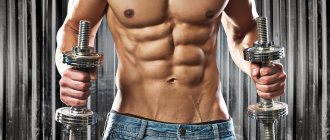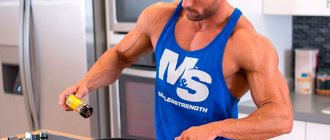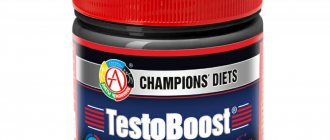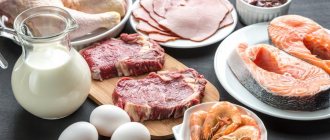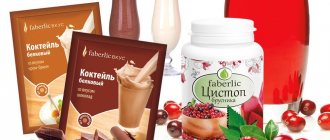Recommendations for muscle growth
Let's consider the basic rules that every athlete who wants to increase muscle mass must adhere to.
- Burn carbohydrates with exercise. Consuming 20% more than your daily calorie intake each day will ensure active muscle growth. To minimize the deposition of fat under the skin, take carbohydrate cocktails 2 hours before. before training and after 1.5 hours. after her.
- Remember the fat-testosterone relationship. Excluding animal triglycerides from an athlete’s menu will inevitably lead to a decrease in the production of male sex hormone, which will negatively affect the development of muscle mass. In addition, a lack of fat reduces the endurance of an athlete by 10% and the performance of an athlete by 12%. It also causes a drop in lactic acid during strength exercises, which is the main sign of ineffective metabolic processes in the body: an increase in the proportion of harmful cholesterol, loss and inability to absorb vitamins and microelements. The daily intake of triglycerides for intensive development of muscle mass is 80-100g. Exceeding this indicator several times leads to the launch of the mechanism of subcutaneous fat deposition. Therefore, effective nutrition for muscle development prohibits the consumption of excessively fatty foods (salty snacks, chips, margarine, mayonnaise, crackers, smoked meats, spreads).
- Reduce cardio loads. To maintain endurance and strengthen the heart, it is enough to limit yourself to cycling training or 1-2 jogs per week for 30 minutes each. Neglecting this condition can lead to “burning” of muscles.
- Reduce the number of repetitions per exercise. The training program for gaining muscle mass is designed for no more than 50 minutes. At the same time, it is important to perform up to 12 repetitions in one exercise. The number of approaches should not exceed 5 times.
- Balanced nutrition (vitamins, minerals, amino acids, dietary supplements). Ideal nutrient ratio for muscle gain:
- fats (polyunsaturated fatty acids) – 10-20% of the daily diet;
carbohydrates (slow or complex) – 50-60%;
- proteins – 30-35%.
- Not to starve. You need to eat 1.5-2 hours before. before classes, preferably carbohydrate foods and after 1 hour. after physical activity. Otherwise, training on an empty stomach will lead to the body starting to intensively burn protein reserves necessary for muscle growth to replenish energy loss. When refreshing yourself, it is important to control the amount of food you eat - do not overeat. After training, you cannot remain hungry; you need to nourish your body with foods rich in minerals and vitamins. A banana, nuts, cottage cheese, protein shake, bun with milk, kefir, gainer, protein, sandwich with jam are suitable as a light snack. And after 1.5 hours. you need to eat well, preferably protein foods, to restore and increase muscles, otherwise exhaustion of the body cannot be avoided.
- Drink plenty of fluids. The daily volume of water consumed during intense training should be 2.5-3 liters. Lack of fluid leads to dehydration, a decrease in muscle strength by 20% and slower muscle growth.
- Rest. The growth of muscle mass does not occur during periods of intense exercise, but during the rest of the body. Stretching and muscle growth occurs within 3-7 days. During this period, it is worth following a diet and alternating between exercise and rest. For beginners, the period of muscle recovery after strength exercises is 72 hours, for trainees – 36 hours. Healthy sleep should be at least 8 hours. in a day. It is important to avoid stress, since nervousness leads to an increase in cortisol levels in the body, which causes fat deposits and muscle loss. Failure to comply with the rest and nutrition regime helps to pump up muscles without increasing volume.
- Change the training program periodically (every two months). For example, introduce new exercises, take additional weight, change the number of repetitions.
- Go towards your goal. Don't walk around the gym doing nothing. To achieve the desired result, you need to concentrate as much as possible on performing the exercise.
The lack of the required amount of useful organic substances in the diet leads to the fact that the body has nowhere to get the required amount of energy to build muscles. An athlete's daily diet for muscle growth should consist of three full meals and two or three light snacks (fruits, nuts, protein shakes).
Following the above key rules for gaining lean muscle mass is an effective path to a healthy, pumped-up body.
If you are overweight, it is important to lose excess fat before performing strength training exercises to increase muscle mass. To do this, you need to take a weight loss course. This is due to the fact that, contrary to popular belief, it is physiologically impossible to “pump” fat into muscles. The protein diet of Dukan and Maggi will help solve this problem.
Basic workouts that promote muscle growth
Now we need to consider how to properly gain muscle mass through training. The program should be designed specifically for your individual capabilities. If you yourself are not very versed in all the intricacies, then contact a professional trainer.
An example is the following program.
Monday (chest, triceps, abs)
- Bench press.
- Lying dumbbell flyes.
- Bench press with a narrow grip.
- Twisting.
- Push-ups on parallel bars.
All exercises are performed in 4 sets of 8-12 repetitions (except for dips and crunches - here do the maximum number of repetitions possible). Before starting the exercise, do 1-2 warm-up approaches with half weight.
Wednesday (biceps, back)
- Wide grip pull-ups.
- Barbell curl (standing).
- Deadlift.
- Lifting dumbbells for biceps (sitting).
- Bent-over dumbbell row to the waist.
We do all exercises in 4 sets of 8-12 repetitions, except for pull-ups, where we do 5 sets with the maximum possible number of repetitions.
Friday (legs, shoulders)
- Seated dumbbell press.
- Squats with a barbell.
- Bench press.
All the same 4 working sets of 8-12 repetitions. Be sure to do a warm-up, and before heavy exercises (squats, presses) - 2-3 warm-up approaches. When doing barbell presses, do not neglect the help of a partner or trainer. After your workout, cool down or stretch.
It is important not to give up training, even if you don’t see results after a month or two. Continue training, adjust your program, review your diet more carefully: powerful biceps and a beautiful back are not a miracle, but the result of hard work. And you will achieve what you want if you don’t stop halfway.
Be sure to give yourself time to rest. Many athletes prefer to train 3 times a week. If this turns out to be too difficult for you, leave 2 workouts. If it’s too easy, most likely you’re not improving in training.
The importance of water and proper nutrition for an athlete
The key to rapid muscle recovery after physical activity is proper nutrition. An unbalanced diet reduces the results of your workout to zero. The effectiveness of strength exercises depends on the literacy of the athlete’s menu.
Benefits of proper nutrition:
- rapid muscle growth;
- increased productivity;
- possibility of increasing the load during training;
- more endurance and energy;
- there is no glycogen deficiency in muscle tissue;
- improved concentration;
- constantly keeping the body in good shape;
- elimination of excess fat deposits;
- insurance against burning protein reserves required for muscle development;
- no need to take long breaks between workouts.
A properly designed nutrition program (see in detail p. Menu for gaining muscle mass) helps to squeeze out maximum energy and strength to perform even the most difficult strength exercises.
Do not underestimate the importance of water during training, since it makes up 75% of the muscles. During sports, an athlete loses a lot of fluid (up to 300 ml in 50 minutes), which leads to dehydration. In order to prevent a violation of the water-salt balance and, as a result, an ineffective workout, it is important to drink a glass of water before starting it, then take a few sips every 10 minutes.
The amount you drink directly depends on the season and the amount of sweat produced. The hotter it is outside and the more sweating, the higher the level of consumption of purified still water should be.
Signs of dehydration:
- headache;
- dizziness;
- fatigue;
- apathy;
- irritability;
- dry mouth;
- chapped lips;
- lack of appetite;
- feeling of thirst.
If at least one of the above symptoms occurs, you should immediately start drinking fluids.
During training, it is allowed to drink freshly squeezed orange juice, diluted with water in a ratio of 50%-50%, or special protein shakes - BCAAs, gainers, which minimize the breakdown of muscle protein, promote energy generation, and speed up the start of the recovery process.
Drug options: MusclePharm Amino 1, BSN Amino X. Immediately after completing the workout, you are allowed to drink milk, green tea, or a protein shake.
Let's consider, using the example of an athletic man weighing 75 kg, the optimal ratio of BJU/calories per day required to increase muscle mass.
Healthy food choices vs. unhealthy food choices
If you need to get 2500 kcal per day and want to increase your size, then consuming 3000 kcal per day in the form of junk and junk food will help you gain weight quite easily.
However, these foods will have a negative impact on your body because depending on what foods you eat, they may not give you the amount of energy you need to achieve your goal, especially if you exercise a lot.
These foods can hinder muscle building because the potential lack of protein won't promote protein synthesis, so you're more likely to gain a lot of fat as well.
On the other hand, if you eat 3,000 calories a day to increase your size, you also calculate the amount of each macronutrient you should consume to reach your goal and adjust those numbers to match your ideal intake. calories - this will give you a better chance of building as much muscle as possible!
This will also help:
✓ Reduction of fat layer;
✓ Using carbohydrates to produce energy and build muscle tissue
The result is an optimal hormonal response that helps in everyday life and training.
Daily calorie intake
For muscle growth, it is important to meet the body's need for the required amount of energy. To do this, you need to calculate your daily calorie intake using the Lyle MacDonald formula or use a specially designed nutrition calculator available on the Internet. In this case, the obtained value should be multiplied by the energy reserve coefficient - 1.2, necessary for muscle development.
Daily calorie intake = Weight, kg * K, kcal/per 1 kg of weight
The K coefficient depends on gender and the intensity of metabolic processes.
| Floor | Metabolism level | Indicator K, kcal |
| Female | slow | 31 |
| Female | fast | 33 |
| Male | slow | 33 |
| Male | fast | 35 |
In our case, the calculation will look like this:
Daily calorie intake = 75kg * 35kcal = 2625kcal
Taking into account the energy reserve correction factor = 2625 kcal * 1.2 = 3150 kcal
Thus, when performing strength exercises, the diet for muscle development in a man weighing 75 kg should be 3150 kcal. Daily caloric intake in this volume, on average, will provide an increase in muscle mass by 2 kg. per month.
Lack of weight indicates a lack of energy and the need to include an additional 400-500 kcal in the daily diet. If your weight gain exceeds 3 kg in 30 days, you should reduce the amount of calories you eat by 300-400 kcal.
As you can see, an athlete’s nutrition schedule depends on the individual characteristics of the body and is subject to constant analysis and adjustment.
Nutrition chart for gaining muscle mass
| Slender body weight, kg | Number of calories consumed, kcal |
| 55 | 2455 |
| 58 | 2634 |
| 63,5 | 2813 |
| 68 | 3037 |
| 70 | 3136 |
| 72,5 | 3260 |
| 77 | 3440 |
| 82 | 3663 |
| 86 | 3885 |
| 91 | 4064 |
| 95 | 4244 |
| 100 | 4467 |
| 104 | 4646 |
| 109 | 4868 |
| 113,5 | 5091 |
| 118 | 5270 |
| 122,5 | 5494 |
Body weight is taken into account without fat mass. For example, the “clean kilograms” of an athlete with 95 kg and 12% body fat are 95-95 * 0.12 = 83.6 kg.
After determining the calorie content of the daily diet, we will consider the correct ratio of nutritional supplements, which make up a sports nutrition complex for muscle development.
The daily intake of carbohydrates is 5g/kg – 4kcal/g, protein – 2g/kg – 4kcal/g, fat – remaining, 1g/kg – 9kcal/g.
For a man weighing 75 kg:
- proteins – 150g. – 600kcal;
- carbohydrates – 375g. – 1500kcal;
- fats – 115g. – 1050kcal.
Subtleties of weight gain for men
Weight gain is largely determined by testosterone levels. If you have problems with muscle growth, despite good nutrition and regular exercise, do a free testosterone test.
A decrease in this hormone can be caused by taking certain medications, various diseases, a lack of substances such as fats, vitamin D, zinc, D-aspartic acid, accumulated fatigue or high levels of stress.
Here lies the answer to the question of how to quickly gain muscle mass for a man. Check hormone levels. Various test boosters based on plant extracts - tribulus, icariin, fenugreek extract - help restore hormonal levels.
Daily protein intake
The most important building material for muscle growth is protein. When doing strength exercises, it is important to ensure that a sufficient amount of protein enters the body every day, based on the calculation of 1.5-2 g/kg of weight. Slow muscle growth indicates a lack of protein, in which case the norm should be increased to 2.5 g/kg.
The athlete's diet should consist of egg whites, cottage cheese with a fat content of 0-9%, fish, lean meats - beef, chicken breast, seafood. You can replenish the required amount of protein in the body of a bodybuilder who does not consume animal products by introducing plant ingredients into the daily menu. Namely, soy milk, legumes (beans, lentils, peas), seeds, nut butters, nuts (almonds, peanuts, hazelnuts, cashews, walnuts, pine, Brazilian, coconut, macadamia, pistachios). However, it is important to consider that a vegetarian diet slows down the process of muscle building due to the lack of animal protein in the diet.
To get the maximum effect, you should drink a protein shake immediately after training, since this is when the body absorbs nutrients best.
As a result of intense exercise, micro-tears of muscle tissue often occur; their healing occurs with the participation of amino acids and protein foods.
The optimal solution for rapid muscle gain is a combination of animal and plant proteins.
Despite the fact that the main building material of muscles is protein, its consumption in excess of the calculated norm leads to an increase in fat deposition in the liver, increased excitability of the endocrine glands, the central nervous system, increased decay processes in the intestines, and an increase in the load on the cardiovascular system. Protein in excess amounts will not be absorbed by the body and will not have an effect on muscle growth.
It is recommended to divide the daily protein intake into 4 meals during the day, which will ensure uniform “feeding” of the muscles throughout the day.
Table of products for the athlete
| Name | Protein content, g |
| Meat and poultry | |
| Beef liver | 17,4 |
| Chicken liver | 20,4 |
| Chicken (breast, drumstick) | 23,09-26,8 |
| Egg | 12.7 (6-7g per 1 piece) |
| Pork | 11,4-16,4 |
| Veal | 19,7 |
| Fish and seafood | |
| Herring | 18 |
| Squid | 18 |
| Cod | 17,5 |
| Tuna | 22,7 |
| Salmon | 20,8 |
| Trout | 22 |
| Crab | 16 |
| Shrimp | 18 |
| Pollock | 15,9 |
| Halibut | 18,9 |
| Milk, dairy products | |
| Cheese 17% | 29 |
| Cheese 45% | 25 |
| Milk 0.5% | 2 |
| Milk 3.2% | 2,8 |
| Cottage cheese 0% (dry in a pack) | 18 |
| Legumes | |
| Beans | 22,3 |
| Lentils | 24,8 |
| Peas | 23 |
| Chickpeas | 20,1 |
| Nuts and seeds | |
| Peanut | 26,3 |
| sunflower seed | 20,7 |
| Walnut | 13,8 |
| Hazelnut | 16,1 |
| Almond | 18,6 |
Protein nutrition not only increases muscle volume, reduces fat deposits, but also makes the body of women and men more prominent.
Daily fat intake
Currently, most athletes are wary of triglycerides. However, there is no need to be afraid of fats; if they are consumed correctly (compliance with the daily norm), they do not transform into adipose tissue. On the contrary, they will have a beneficial effect on muscle growth.
Namely, fats take an active part in the production of hormones, which, in turn, are involved in building muscles. For testosterone production, it is important that the daily intake of triglycerides in the body is at least 15% of the total diet.
The following types of fats are distinguished:
- healthy (monounsaturated and polyunsaturated);
- harmful (saturated).
Monounsaturated triglycerides include: avocados, olives, chicken, olive and peanut meat. These products are a storehouse of healthy Omega 9 fatty acids, which speed up metabolism, stabilize blood sugar levels, and protect the heart from the harmful effects of blood pressure fluctuations.
Sources of polyunsaturated triglycerides (Omega-3.6) are: fish oil, cottonseed, soybean, corn, sunflower, flaxseed, rapeseed oil, as well as seeds and nuts. Fatty acids in this category improve the anabolic response of protein and insulin, increase performance, and increase performance, which is especially important during heavy strength exercises.
Sports nutrition while gaining muscle mass excludes the consumption of saturated triglycerides found in butter, palm, coconut, cocoa butter, lard, red meat, and confectionery products.
This is due to the fact that the molecule of harmful fat is completely saturated with hydrogen and contains “bad” cholesterol, which means it can provoke the development of obesity, heart disease, and diabetes. Therefore, the main sources of healthy triglycerides in an athlete’s menu are fatty fish, vegetable oils, and nuts. It is allowed to include in the diet milk 3.2%, cottage cheese, cheese 9%.
Subtleties of weight gain for women
Many girls are afraid of training, especially with weights, mistakenly believing that they are the cause of a “pumped up” body and are afraid of making their figure masculine. These fears are completely unfounded - without taking hormonal drugs, it will not be possible to achieve excessive hypertrophy. This means you can safely go to the gym and pick up a barbell. In principle, women’s muscles grow less than men’s, so without any fear, you can include strength exercises in your training program - they will help you lose weight, tighten your arms, and provide elastic buttocks and a beautiful back line. Moreover, the emphasis should be on basic multi-joint exercises; they will provide good, uniform development of all major muscle groups. Trying to focus on isolation exercises to bulk up your butt without swinging your legs, or to tighten your arms without training your biceps, is a mistake.
But on average, girls gain fat mass more easily, so a more careful calculation of calories is required, paying more attention to the quality of food and its balanced composition. Muscles grow in response to stimuli in the form of exercise, so when you wonder how a woman can gain muscle mass? – you need to understand that this can only be done through strength training.
Daily carbohydrate intake
The main source of energy is carbohydrates.
Nutrition for gaining muscle mass involves taking 5g daily. organic compounds containing hydroxyl and carbonyl groups per 1 kg of own body weight. The role of carbohydrates is to increase insulin/hormone levels in the body and help repair tissue after exercise. In addition, they serve to transport nutrients directly to muscle cells.
A lack of carbohydrates in an athlete’s diet causes apathy, weakness, decreased performance, and reluctance to continue training. Muscle development is impossible without consuming carbohydrates.
Depending on the rate of splitting, they are:
- fast (simple), it is preferable to consume them an hour before, immediately after sports, as they are perfect for quickly restoring spent energy reserves;
- slow (complex), they should be eaten 2 hours before physical activity.
Products containing 50g. fast carbohydrates per 100g ingredient: jam, cookies, sugar, candy, halva, condensed milk, raisins, figs, honey, chocolate, dates, pineapple, cakes, crackers, pasta, white bread, waffles, gingerbread, semolina, rolls.
Ingredients containing complex organic compounds more than 50g. per 100g: beans, chickpeas, lentils, peas, buckwheat, rice, oatmeal, bread, pasta.
Slow carbohydrates should be included in the daily menu for gaining muscle mass for girls and boys, since they are the main source of energy not only for the muscles, but also for the brain.
Products containing simple organic compounds in moderate quantities - 20g per 100g: all sweet berries, fruits (most in persimmons, bananas, grapes, less in citrus fruits, apples), boiled potatoes, carbonated drinks (lemonade, Coca-Cola, Sprite, Fanta, Burn, Schweppes, Pepsi, Fruktime). The latter, in turn, should be avoided, since such drinks do not contain useful substances and do not satisfy hunger.
Products with a minimum carbohydrate content – 10g. per 100g: dairy products, fresh vegetables (eggplant, tomatoes, cucumbers, cabbage, carrots). In addition to enriching the body with healthy carbohydrates, they contain everything necessary (vitamins, minerals, fiber) to improve the digestion of food in large quantities.
Thus, in the process of selecting the optimal ratio of BJU, you should, first of all, focus on your own well-being. If during the period of strength training you experience a surge of energy by consuming more carbohydrates than the daily norm “allows”, the amount of fat can be reduced to 0.8 g/kg.
The key to a successful workout is the athlete’s well-being.
If apathy occurs during physical activity, fats should be increased to 2g/kg, and carbohydrates should be reduced in direct proportion. Adjusting your diet to suit your body’s individual characteristics will increase the effectiveness of your stay in the gym.
A rapid gain of muscle mass is possible only if the following conditions are met:
- natural balanced nutrition;
- healthy eight-hour sleep;
- a properly selected set of strength exercises.
Violation of at least one of them leads to a decrease in the effectiveness of training and a slowdown in muscle development.
Menu for gaining muscle mass
Building muscle is a long process that requires self-discipline in nutrition. Eating five meals a day every three hours is a reliable way to achieve the desired result.
The best nutrition for an athlete is fractional, it ensures the systematic intake of food into the body in small doses, which helps accelerate synthesis, improve protein absorption, metabolism, having a positive effect on muscle growth.
It is strictly forbidden to skip meals, go hungry or overeat. In the first case, separate nutrition will not bring the desired effect - the muscles will not increase in volume, in the second - it will lead to excess weight gain and the deposition of fat under the skin.
Sample daily menu for an athlete to increase muscle mass
Let's look at options for each meal. Choose any of them, focusing on taste preferences and individual characteristics of the body (ectomorph).
BREAKFAST
- Banana – 1 pc., black bread – 2 slices, omelette from two egg whites of one whole.
- Pear – 1 pc., cocoa, oatmeal – 150g, dark chocolate – 30g.
- Apple – 1 pc., milk, buckwheat porridge – 150g.
- Yogurt – 100g, rolled oats – 50g, cottage cheese 9% – 100g.
SNACK #1 (pre-workout)
- Kefir 0% or 1%, cheese – 50g, bread – 2 slices.
- Black tea, low-fat cottage cheese – 200g, raspberry jam or honey – 4 tsp.
- Unsweetened oatmeal – 150g, jam – 3 tsp, grapefruit – 1 pc.
- Apple – 1 pc., nuts (assorted) – 40g, prunes, raisins, dried apricots, prunes – 80g.
- Banana – 1 pc., protein – 1.5 scoops, rye bread – 3 slices, peanuts – 30g.
DINNER
- Avocado – 150g. (half), boiled turkey fillet – 100g, unpolished rice – 100g.
- Beef broth soup – 200ml, dried fruit compote, buckwheat – 100g, chicken – 150g, vegetable salad – 100g.
- Rice – 100g, milk 1%, turkey 150g or 2 whole eggs.
- Carrot or orange juice, banana – 1 piece, mashed potatoes – 100g, poultry meat – 150g.
- Green tea, honey – 2 tsp, vegetable puree soup – 200 ml, fish – 200 g, rice – 100 g, grapes – 200 g.
SNACK #2 (immediately after training)
- Gainer + nuts – 40g, dark chocolate – 50g.
- Black tea, raspberry jam or honey - 5 tsp, low-fat cottage cheese - 200g.
- Banana – 2 pcs., dark chocolate – 50g.
- Milk, oatmeal – 150g.
- Pineapple smoothie with chocolate pieces, bread - 2 slices.
- Apple – 1 pc., egg yolks – 2 pcs., whites – 4 pcs., almonds – 50g.
- Dried fruits – 100g, nuts – 40g.
DINNER
- Broccoli – 100g, boiled beef/chicken breast – 200g, rice – 100g.
- Berry fruit drink, egg whites – 5 pcs, vegetable salad – 150g.
- Fish – 200g, green tea, orange – 1 pc.
- Nuts – 50g, raspberry jam – 4 tsp, low-fat cottage cheese – 150g.
- Buckwheat – 100g, turkey – 200g, vegetable oil – 3 tbsp, cabbage and carrot salad – 100g.
- Mashed potatoes – 100g, veal – 150g, stewed vegetables – 100g, banana – 1 pc.
The presented variations serve as the basis for creating a menu for the week.
You can make changes to the nutrition plan: replace products with analogues according to BZHU. To supply the athlete with strength, in 1 hour. before the start of training, the menu (snack No. 1) consists of fast and slow carbohydrates. They act as the main sources of energy. At the same time, proteins and saccharides will help replenish wasted energy and ensure muscle growth after exercise (snack No. 2).
If the nutrition when gaining muscle mass is balanced and calculated correctly, the first results can be observed after 3 weeks.
If at the end of this period there is no weight gain, carbohydrate intake should be increased by 50g. after training, at breakfast.
An example of a diet (schedule) for a vegetarian athlete to increase muscle mass
BREAKFAST
- Green tea, tofu cheese – 100g. bread - 2 slices.
- Freshly squeezed juice from cucumber, green apple, cabbage, spinach, ginger, celery – 450 ml, protein shake from almond milk (1 glass), banana (1 pc.), soy protein (2 tbsp.) – 200 ml.
SNACK #1
- Carrot casserole or cheesecakes – 150g, mixed nuts – 40g/peanut butter – 1 tbsp.
- Pumpkin-almond oil - 2 tsp, oatmeal - 150g, tofu - 100g.
- Protein bar – 1 pc., apple-grapefruit cocktail.
DINNER
- Vegetable soup – 250ml, stewed zucchini, carrots, broccoli – 100g, soy meat – 150g, tempeh – 100g.
- Burger with avocado and cheese – 1 pc., cabbage salad with tomatoes – 150g, banana – 1 pc., broccoli and spinach cream soup – 200 ml., almond butter – 2 tsp.
- Kion rice – 100g, lentil and couscous salad – 100g, seitan – 50g, quinoa seeds – 1 tsp, olive oil – 1 tsp.
- Pea soup - 200ml, cheese - 100g, buckwheat porridge - 100g, tomato and spinach salad - 100g.
SNACK #2
- Kefir, pumpkin or sunflower seeds – 80g, fruit jam – 5 tsp, bread – 1 slice.
- Dried fruits – 100g, peanut butter – 1 tbsp.
- Protein shake made from banana, almond milk and hemp protein with dark chocolate pieces.
DINNER
- Flaxseed porridge – 100g, steamed pumpkin-carrot cutlets – 3 pcs, berry smoothie or jelly, cabbage salad, tomatoes, walnuts – 150g.
- Rice or mashed potatoes with cheese – 100g, boiled broccoli – 150g, avocado – 100g (half), tofu – 50g.
Vegetarian nutrition during the period of gaining muscle mass should be as balanced as possible. Animal proteins (fish, shellfish, eggs, meat) should be replaced with: tempeh, nuts, kefir 0%, low-fat cottage cheese, yogurt 2.5%, Mozzarella, Riccotta cheeses, soy products, tofu, legumes. However, you should not overload your body with protein products. To increase muscle mass, the daily protein intake is 2g/kg, for maintenance – 1.5g.
For vegetarians, the ideal training regimen is intense but short (up to 30 minutes). This is due to the fact that prolonged exercise “uses up” a large supply of protein, which is problematic to accumulate on foods of plant origin.

